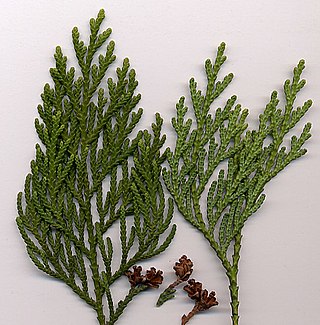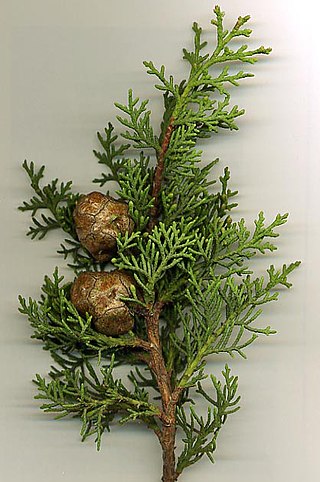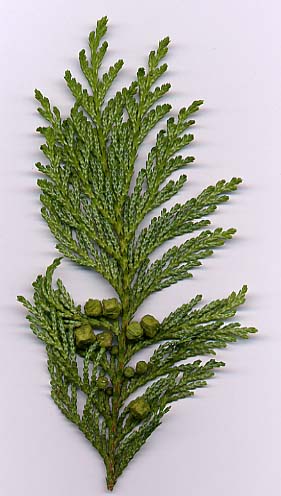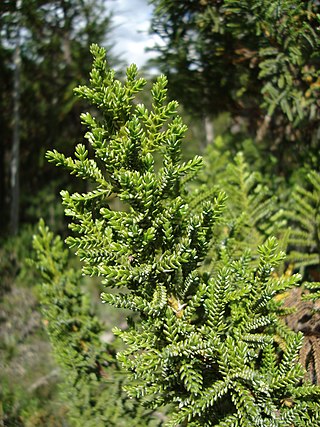
Thuja is a genus of coniferous tree or shrub in the Cupressaceae. There are five species in the genus, two native to North America and three native to eastern Asia. The genus is monophyletic and sister to Thujopsis. Members are commonly known as arborvitaes, thujas or cedars.

Cupressaceae is a conifer family, the cypress family, with worldwide distribution. The family includes 27–30 genera, which include the junipers and redwoods, with about 130–140 species in total. They are monoecious, subdioecious or (rarely) dioecious trees and shrubs up to 116 m (381 ft) tall. The bark of mature trees is commonly orange- to red- brown and of stringy texture, often flaking or peeling in vertical strips, but smooth, scaly or hard and square-cracked in some species.

Chamaecyparis, common names cypress or false cypress, is a genus of conifers in the cypress family Cupressaceae, native to eastern Asia and to the western and eastern margins of the United States. The name is derived from the Greek khamai (χαμαί), meaning "on the earth", and kuparissos (κυπάρισσος) for "cypress".

Pilgerodendron is a genus of conifer belonging to the cypress family Cupressaceae. It has only one species, Pilgerodendron uviferum, which is endemic to the Valdivian temperate rain forests and Magellanic subpolar forests of southern Chile and southwestern Argentina. It grows from 40 to 54°20' S in Tierra del Fuego, where it is the southernmost conifer in the world. It is a member of subfamily Callitroideae, a group of distinct Southern Hemisphere genera associated with the Antarctic flora.

Chamaecyparis pisifera is a species of false cypress, native to central and southern Japan, on the islands of Honshū and Kyūshū.

Libocedrus is a genus of five species of coniferous trees in the cypress family Cupressaceae, native to New Zealand and New Caledonia. The genus is closely related to the South American genera Pilgerodendron and Austrocedrus, and the New Guinean genus Papuacedrus, both of which are included within Libocedrus by some botanists. These genera are rather similar to the Northern Hemisphere genera Calocedrus and Thuja: in earlier days, what is now Calocedrus was sometimes included in Libocedrus. They are much less closely related, as recently confirmed. The generic name means "teardrop cedar", apparently referring to drops of resin.

Austrocedrus is a genus of conifer belonging to the cypress family (Cupressaceae). It has only one species, Austrocedrus chilensis, native to the Valdivian temperate rain forests and the adjacent drier steppe-forests of central-southern Chile and western Argentina from 33°S to 44°S latitude. It is known in its native area as ciprés de la cordillera or cordilleran cypress, and elsewhere by the scientific name as Austrocedrus, or sometimes as Chilean incense-cedar or Chilean cedar. The generic name means "southern cedar".

Juniperus sabina, the savin juniper or savin, is a species of juniper native to the mountains of central and southern Europe and western and central Asia, from Spain to eastern Siberia, typically growing at altitudes of 1,000–3,300 metres.

Calocedrus decurrens, with the common names incense cedar and California incense cedar, is a species of coniferous tree native to western North America. It is the most widely known species in the genus, and is often simply called incense cedar without the regional qualifier.

Cupressus funebris, the Chinese weeping cypress, is a species of cypress native to southwestern and central China. It may also occur naturally in Vietnam.

Calocedrus formosana is a conifer endemic to Taiwan.

Calocedrus macrolepis is a conifer native to southwest China, northern Vietnam, northern Laos, extreme northern Thailand and northeastern Myanmar.

Chamaecyparis formosensis is a species of Chamaecyparis, endemic to Taiwan, where it grows in the central mountains at moderate to high altitudes of 1000–2900 m. It is threatened by habitat loss and over-cutting for its valuable timber.

Juniperus tibetica, the Tibetan juniper, is a species of juniper, native to western China in southern Gansu, southeastern Qinghai, Sichuan, and Tibet Autonomous Region, where it grows at high to very high altitudes of 2,600–4,900 metres. This species has the highest known elevation treeline in the northern hemisphere.
Libocedrus austrocaledonica is a species of Libocedrus, endemic to New Caledonia, occurring mainly in the southern half of the island, at 750–1,400 m altitude in montane cloud forest scrub.

Libocedrus bidwillii, also called pāhautea, kaikawaka or New Zealand cedar, is a species of Libocedrus, endemic to New Zealand. It is in the cypress family Cupressaceae.
Libocedrus chevalieri is a species of conifer in the cypress family, Cupressaceae. It is endemic to New Caledonia, occurring in three small, isolated populations on low mountain summits at 650–1,620 m altitude in cloud forest scrub on serpentine soils. It is threatened by habitat loss.

Libocedrus plumosa, with the common name kawaka, is a species of Libocedrus that is endemic to New Zealand.
Libocedrus yateensis is a species of Libocedrus, endemic to New Caledonia, occurring in a few small, isolated populations in low-elevation riverside sites at 150–600 m elevation in rainforest scrub. It is threatened by habitat loss.

Chamaecyparis taiwanensis is a species of cypress, native to the mountains of Taiwan, where it grows at altitudes of 1300–2800 m.


















